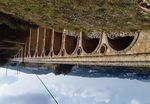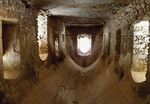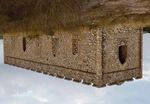An English church on Kythera - Paul Watkins explores the relics of Britain's Greek Empire on Kythera - revised_BIAA
←
→
Page content transcription
If your browser does not render page correctly, please read the page content below
MODERN
© Howard King
An English church on Kythera
Paul Watkins explores the relics of Britain’s Greek Empire on Kythera
‘I have been asked where the Ionians were?
And what England could have to do with the people of Persia?’
Lord Kirkwall, former official of the Lord High Commissioner
during the British rule of the Ionian islands, 1815–1864
ne of the unsung joys of construction of a small domed Sadly the church’s landmark
O travel is the moment when
you open the shutters of a
darkened hotel room to the
church in the Byzantine style,
dedicated to the Orthodox St Martin
(Ayios Minas) and later on, in the
dome had recently collapsed and I
realized that the building I was
contemplating was now no more
wakening view. A late arrival in 16th century, transferred to the than a ruinous memorial to a short-
Chora, capital of the Greek island of Catholic faith as part of a Franciscan lived but intriguing period in the
Kythera, provided me with such a monastery. island’s history.
pleasure. With the need for a good Later still, in the early 19th
night’s sleep paramount, the century, Ayios Minas became the ‘King Tom’ and his ‘Viceroys’
shutters had remained closed until ‘English Church’, converting to the British occupation of the seven
morning. Protestant faith during the British Ionian islands was the result of the
Framed by the open window was occupation of the Ionian islands withering of French power in the
the revelation of a shallow, verdant (1815–1864). In its brief life as an Mediterranean during the
valley, with only one man-made Anglican place of worship for the Napoleonic Wars. Napoleon had
feature. At first I could not clearly handful of British soldiers and seized them from the Venetians in
identify the tumbled mass of stone, administrators and their families, the 1797 prior to his campaign in Egypt,
glowing warmly in the early morning church played an important if minor but his subsequent defeat at the
light, as a building. All I knew was role in maintaining the idiosyncracy Battle of the Nile in 1798 brought
that at some time in the island’s early of a British Greek Empire, formed of their surrender to the forces of
Venetian period (13th century) the Kythera and the other Ionian islands Russia and Turkey – two of the
site had been chosen for the dominated by Corfu. powers allied against the French. A
21argo
© Howard King
The Mentor shipwreck
On 12 September 1802 a British
ship, the Mentor, was sailing from
Athens to Malta with a precious
cargo: 17 crates of marble sculp-
tures newly removed from the
Parthenon by Lord Elgin. The route
of the voyage, via the southern
coastline of the Peloponnese, was
diverted by strong northwesterlies
to the southern tip of Kythera, where
it took on water. In desperation, the
crew made for the island’s nearest
port, Avlemonas, on the east coast.
Unfortunately the heavily weighted
ship struck the shore just outside
the harbour and quickly sank.
Happily all on board were saved.
Among them was Lord Elgin’s
private secretary, William Hamilton,
who had been involved in a similar
mission – the removal of the
Rosetta Stone from Egypt – the
previous year. (This was the same
Hamilton who later became Britain’s Derelict interior of the ‘English Church’.
Envoy to Naples and protector and
husband of Nelson’s Emma.) His
companion on the voyage, another period of independence created a and offered little opposition to
great philhellene, was Colonel ‘Septinsular Republic’ but this only Maitland’s rule. But a colonial
William Martin Leake, renowned for lasted until 1807, when the French adventure that might have seemed
his geographical surveys of Greece briefly returned, then to be finally little more than a move on the geopo-
and, like Hamilton, a dedicated
evicted by the British after a long litical chessboard had a positive
collector of antiquities.
It was essential that the marbles blockade (1809–1814). The British outcome for the inhabitants of Corfu,
– along with Lord Elgin’s reputation protectorate imposed on the islands Paxos, Levkas, Cephalonia,
– were recovered. Sponge divers lasted until 1864 when they were Zakinthos, Ithaca and Kythera,
from Symi and Kalymnos were united with Greece. bringing about a degree of order, local
recruited to explore the wreck and
The first overlord of Britain’s justice and material advancement for
retrieve its priceless cargo, which
was subsequently shipped to Greek possessions, commanding the islands unknown in their history.
England in two Royal Navy his insular domain from a splendid In this respect, Maitland’s
vessels.* Sold to the British palace on Corfu, was Lord High ‘viceroys’ had a major role to play.
Museum by Lord Elgin, the marbles Commissioner Sir Thomas Maitland. These men, colonial officials and
remain there as a major attraction
Something of a maverick in the great army officers, were made Residents
for visitors despite the efforts of
Greece to repatriate them. tradition of British colonial (governors) of the smaller islands,
Under the supervision of the governors, ‘King Tom’ was the where their exploitation of the people
Greek Archaeological Committee, guardian and executor of a consti- and resources was to some extent
excavations of the shipwreck have tution which ensured control of the balanced by their contribution to the
continued into the 21st century.
Islands’ Assembly, and which could general good. Kythera’s best-known
Some of the other antiquities
stowed on the Mentor along with the enact legislation without the Resident, Captain John McPhail, is
marbles have been recovered, and authority of a British parliament. He remembered for his public works,
much has been learnt about ship was effectively an independent the product of his training as an
design and equipment of the period. sovereign with complete power over architect and engineer. The island’s
*Although the British were not in
his subjects. His view of their road network, still in use today, was
control of the Ionians at the time of political rights was best summed up largely his creation (and that of the
the shipwreck, it has been suggested by his confident assertion that islanders’ corvée labour) as were the
by the historian G.N. Leontsinis, ‘colonial assemblies are injurious to splendid bridges, many still capable
author of a doctoral thesis on the the people and disadvantageous to of carrying modern traffic. McPhail’s
social history of Kythera, that the
islanders were strongly pro-British
good government’. most interesting architectural legacy,
(following the expulsion of the Though forming part of the Ionian however, is the half-dozen or so
French and the setting up of the Assembly, the noble families who had school buildings whose English
short-lived Septinsular Republic), governed the islands in the 400-year Gothic design stands out so strik-
and thus happy to permit the export Venetian period were subverted by ingly against the Kytheran
of their Greek heritage.
the offer of large salaries and titles, landscape (see panel on page 23).
22MODERN
These schools, serving a population
swollen by refugees from the Greek The British architectural legacy on Kythera
War of Independence, were built for
the purpose of educating a Greek
civil service to provide future recruits
for the British administration.
The ‘English Church’
I followed the track to Ayios Minas
along the valley floor to a small
cemetery behind the church, where
a path between the marble Orthodox British School, Milapidia, exterior and interior (© Paul Watkins).
tombs led to a square stone vault
shaded by a pine tree. A carved Schoolhouses
inscription showed that this was an One of John McPhail’s most inspired projects was the building of schools
ossuary containing the bones of the throughout Kythera to educate local children as potential administrators.
British residents who had been disin- The schools were based on the Lancastrian system, which owes its name
terred from an earlier graveyard and to the pioneering work of Joseph Lancaster (1778–1838), in establishing
from the interior of the church, trans- schools in which more advanced students assumed the role of teachers,
ferred here in 1935. Inside the thus alleviating the burdens – and cost – of adult staff. The method was
church a plaque from 1971 recorded highly influential in the earlier part of the 19th century, which included the
period of school construction on Kythera (1820s). McPhail’s venture had
this event in Greek and English.
the enthusiastic support of Frederick North, Fifth Earl of Guilford, who
Apart from a second plaque
established the Ionian Academy on Corfu, the first university of modern
(1623) commemorating a Venetian Greece.
burial within the church, the interior British schoolhouses, mainly built in the years around 1825, can be
was bare, with crumbling plaster found at Potamos, Milopotamos (Kato Chora), Milapidia, Fratsia, Osios
revealing the ragged stonework and Theodoros and Aroniadika. They are notable for their derivative architec-
an east end open to the sky. The tural styles, inspired by the contemporary fads of British academe (such
sanctuary was buried by the rubble as the neo-Gothic). As in the case of Chora’s ‘English Church’, however,
of the recently collapsed dome. Here these buildings have lacked any substantial restoration and are in a sad
was a sad glimpse of a misplaced state of disrepair.
and near-forgotten imperialism. The
church, like so many similar relics on Bridges and other structures
Their modern function has ensured that McPhail’s bridges are better
the island, is unlikely to be restored.
preserved than the schools. Most notable are those at Katouni, Kapsali,
A memory of Kythera’s British
Potamos, Mitata and Karavas. Other British works include the lighthouse
community survives, however, in the at Moudari (1854) at the northern end of the island, the market building at
Archaeological Museum of Chora. Chora (1834) and the Lazaretto (quarantine station) at Kapsali, an 1817
Here the headstones from their reconstruction of the original Venetian building. Also at Kapsali is a tall,
former graves have been stored and stone-built reservoir (1825), once supplied by an aqueduct, used for
archived. Sadly, the engraved watering the ships which came into the harbour.
epitaphs give little information on the
burials, with no reference to the
birthplace or place of death (i.e.
Kythera) of the men, women and
children who found themselves so
far from their homeland. This speaks
volumes about the attitude of the
British expatriates towards their
adopted home, which they saw as
foreign and remote.
The most celebrated antiquity in Bridges at Kapsali (left) and Katouni (© Paul Watkins).
the museum is undoubtedy the
impressive Archaic ‘Lion of Kythera’ Acknowledgements
(sixth century BC) which stands The author would like to thank Howard King, Ann Morton, Lita Tzort-
proudly near the entrance. This zopoulou-Gregory, Eleni Harou and Marieta Fyrou for their helpful infor-
cannot be mistaken for any other mation, and Jim and Annie Tzannes for their generous hospitality and
symbolic lion, either Venetian or assistance on Kythera.
British.
23You can also read























































